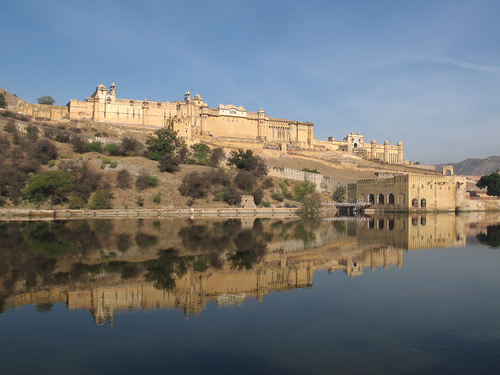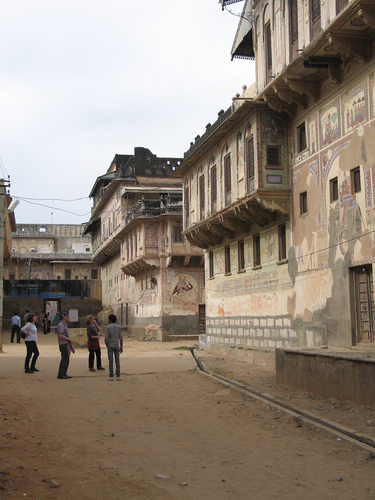The Historic Urban Landscape Recommendation (UNESCO Recommendation on the Historic Urban Landscape HUL Citation2011) proposes that heritage management should be holistic, integrated with existing policy, people-centred and focused on sustainable development goals. HUL has figured prominently in the pages of this journal. Equally familiar is India’s rich historic urban environment, its high-profile sites, where visitor numbers are measured in the hundreds of thousands (), to locations which are less well known ().
Figure 1. The amber fort, Jaipur, Rajasthan which in 2007 received over 1.4m visits a year (photo M Dawson).

Figure 2. A Merchant Havelis in Nawalgarh, Rajasthan, grand mansions built by wealthy merchants in the early 18th century, with intricate frescoes and murals, depicting everyday life, folk legends, and religious themes. However, as Vibha Upadhyaya, noted in 2017 lack of maintenance has left many buildings in a dilapidated state and heritage is being lost.Footnote1 (photo M Dawson).

In the first paper of this volume Aditi Sharma and Rawal Singh Aulakh of the Department of Architecture, Guru Nanak Dev University, Amritsar, review the role of HUL in the context of Indian heritage management policies. The authors identify the challenges faced in preserving and managing historic urban areas and provide recommendations to enhance the integration of HUL approaches within existing policy frameworks. The complex nature of urban heritage and the competing demands of sustainable development are presented in the face of inadequate funding, rapid urbanisation, and development pressures. It is a situation made more complex by poor documentation and outdated records combined with inadequate public awareness and lack of engagement. Such factors are further exacerbated by the effects of climate change, illegal trafficking, and vandalism. Occupying positions of responsibility as teachers of the next generation of conservation professionals, the authors have identified practical steps for policymakers and urban planners to incorporate the HUL principles into Indian heritage management.
The history of conservation as a worldwide phenomenon has been the subject of several publications in recent years, often with only passing reference to conservation practice in Turkey.Footnote2 Papers in this journal have supplied more detail, though with significant emphasis on the management of World Heritage sites as tourist destinations. In the late 19th century, the conservation of Byzantine Heritage in the Ottoman Empire was not significant, and where it occurred was often subject to the needs of the military. In a paper by Elif Acar Bilgin and Figen Kıvılcım Çorakbaş at the Department of Architecture, Bursa Uludağ University, the hitherto largely unrecognised contribution of an Historic Peninsula Fortification Map of 1893 to the development of conservation in Turkey is explored. Historic Istanbul, surrounded by Byzantine-period walls, has been represented on maps and drawings by Ottoman and foreign mapmakers since the 15th century. The Historic Peninsula Fortification (HPF) Map, held in the national archives of Istanbul, was itself probably an amended copy of the earlier Ayverdi Map. Although it was not one of the first architectural studies focusing on the city walls, the authors argue the detailed map made an important contribution to emerging concern for the conservation of Byzantine remains. It was one of the small, yet incremental steps which led to the formulation of wider conservation policy.
For the third paper, we remain in Turkey but move eastwards to Cappadocia, and once again focus on the impact of tourism on the historic environment. In an assessment of development on the historic environment, Fatma Büke at Çankaya University, Ankara reviews the damaging effects of tourism in traditional settlements. In Cappadocia, where adaptive reuse of individual vernacular houses has transformed an entire neighbourhood, the historic environment of Kayakapı has become a ‘holiday village.’ Arguing that the current situation is incompatible with the values of international heritage and conservation policy, the transformation of Kayakapı is attributed to ‘gentrification’ and ‘Disneyfication’. Both are controversial effects, where tourism, detached from local communities, has led to the settlements becoming ‘stereotypical and depersonalised.’
Adaptive re-use of historic buildings emerged as a formal response to the climate of demolition in the late 20th century. Often it has been the most substantial of buildings which were repurposed and some like the former Dunlop building in Birmingham, England and recently the Domino Sugar refinery in New York City, have become iconic symbols of regeneration. Nevertheless, re-use has the potential to embody important historic values. The repurposed border posts of Europe are valued as indicators of a more divided past and some specifically of the 1985 Schengen agreement.Footnote3 In the Williamsburg district of Brooklyn, the Domino building represents a demographic shift from labour to living and reflects the need for a more mixed city where, post-pandemic, people will want to live and work. However, the heritage value of the building lies not in the quality of the structure, which is retained as a scarred brick shell, but in the capacity of the structure to act as a marker of authenticity, not a place to remember but to reflect.Footnote4
Today the value of re-use has been recognised beyond heritage values as part of the sustainability agenda and response to climate change in which embodied carbon and energy are important factors. In many cases re-use and the maintenance of heritage values involves buildings for which there is no precise policy framework, technical guidance, or best practice advice and where redevelopment is controlled only through building regulations, individual and professional practice.
Adaptive re-use of industrial heritage is taken up by colleagues Farzaneh Gharaati and Mohammadjavad Mahdavinejad, at Tarbiat Modares University, Tehran with Adam Nadolny, and Hassan Bazazzadeh at Poznan University, Poland. Their subject is the reuse of industrial heritage in Iran where, although industrial buildings are protected by designation, there are no precise guidelines or policies for their conservation or re-use. Interviewing five experts through the medium of focus group discussion they have assessed their case studies to find the strengths and weaknesses of conservation practice, measuring the results against criteria derived from a range of international charters. Ultimately, it is their recommendation that in the absence of local policy frameworks, conservation professionals should gauge their performance by the principles of international guidelines and practice rather than attempt to re-invent a local tradition.
Counter mapping has been described as a means to ‘chart the stories and customs of those who would traditionally be ignored.’Footnote5 Formally it is a methodology which is today associated with the community voice in the development, management and sustainability of heritage.Footnote6 In the final paper of this volume Sarah Baker and Chelsea Evans at Griffith University, Gold Coast, and Zelmarie Cantillon at Western Sydney University, Parramatta, Australia present the results of counter-mapping and community mapping by Pitcairn Settler descendants and others with long connections to Norfolk Island. The island is part of the Australian Convict Sites WHS which extends from Fremantle in Western Australia to Kingston and Arthur’s Vale on Norfolk Island in the east; and from areas around Sydney in New South Wales in the north to sites located in Tasmania in the south.Footnote7 The nature of the inscription means that the island’s heritage is dominated by a Eurocentric narrative. According to the Outstanding Universal Value (OUV) synthesis ‘Within the colonial system established in Australia, the convict settlements simultaneously led to the Aboriginal population being forced back into the less fertile hinterland, and to the creation of a significant source of population of European origin.’Footnote8 In ‘Mapping Living Heritage … ’ the authors highlight ‘the importance of protecting heritage in ways that account for everyday and contemporary experiences, emotional resonances, and unbounded uses of this living heritage site.’ This is an important paper which has wide implications for heritage in general, Conservation and Management Plans of the future, and for the creation of policy which genuinely engages with communities as custodians of their own heritage.
Disclosure statement
No potential conflict of interest was reported by the author(s).
Notes
1. Upadhyaya, Citation2017.
2. Jokilehto, Citation2018, 344, who describes the late 19th century origins of Turkish architectural conservation; Glendinning, Citation2013, notes the attack by Ruskin on Ottoman practice in 1876–8 and the later radical archaeological intervention under Kemal Ataturk to establish national roots in Sumerian and Hittite civilisations.
3. Popescu, 2023.
4. Heathcote, 2023.
5. O’Dwyer, Citation2018.
6. Perkins, Citation2018; Schofield, Citation2016.
7. https://whc.unesco.org/en/list/1306 Accessed oct 31, 2023
8. https://whc.unesco.org/en/list/1306 Accessed oct 31, 2023
Bibliography
- Glendinning, M. The Conservation Movement a History of Architectural Preservation. Antiquity to Modernity. London: Routledge, 2013.
- Heathcote, E. “The Domino Effect.” Financial Times Weekend, Oct 7th–8th, 2023.
- Jokilehto, J. A History of Architectural Conservation. London: Routledge, 2018.
- O’Dwyer, L. “Counter-Mapping: Cartography That Lets the Powerless Speak. How a Subversive Form of Mapmaking Charts the Stories and Customs of Those Who Would Traditionally Be Ignored. Guardian. Mar 6th, 2018. Accessed oct 31, 2023. https://www.theguardian.com/science/blog/2018/mar/06/counter-mapping-cartography-that-lets-the-powerless-speak
- Perkins, C. “Community Mapping.” Oxford Bibliographies. Oxford: Oxford University Press, 2018. Accessed oct 31, 2023. https://pure.manchester.ac.uk/ws/portalfiles/portal/75071638/Community_Mapping.pdf
- Popescu, L. ”‘Borders and Breadlines in Forgotten Europe.” Guardian Oct 8th, 2023
- Schofield, J. Who Needs Experts? Counter-Mapping Cultural Heritage. London: Routledge, 2016.
- UNESCO Recommendation on the Historic Urban Landscape (HUL), UNESCO. 2011. Accessed oct 31, 2023. https://unesdoc.unesco.org/ark:/48223/pf0000215084
- Upadhyaya, V. “Transformation in Traditional Havelis: A Case of Walled City Jaipur, Rajasthan.” Imperial Journal of Interdisciplinary Research 3, no. 2 (2017): 1482–1492.
